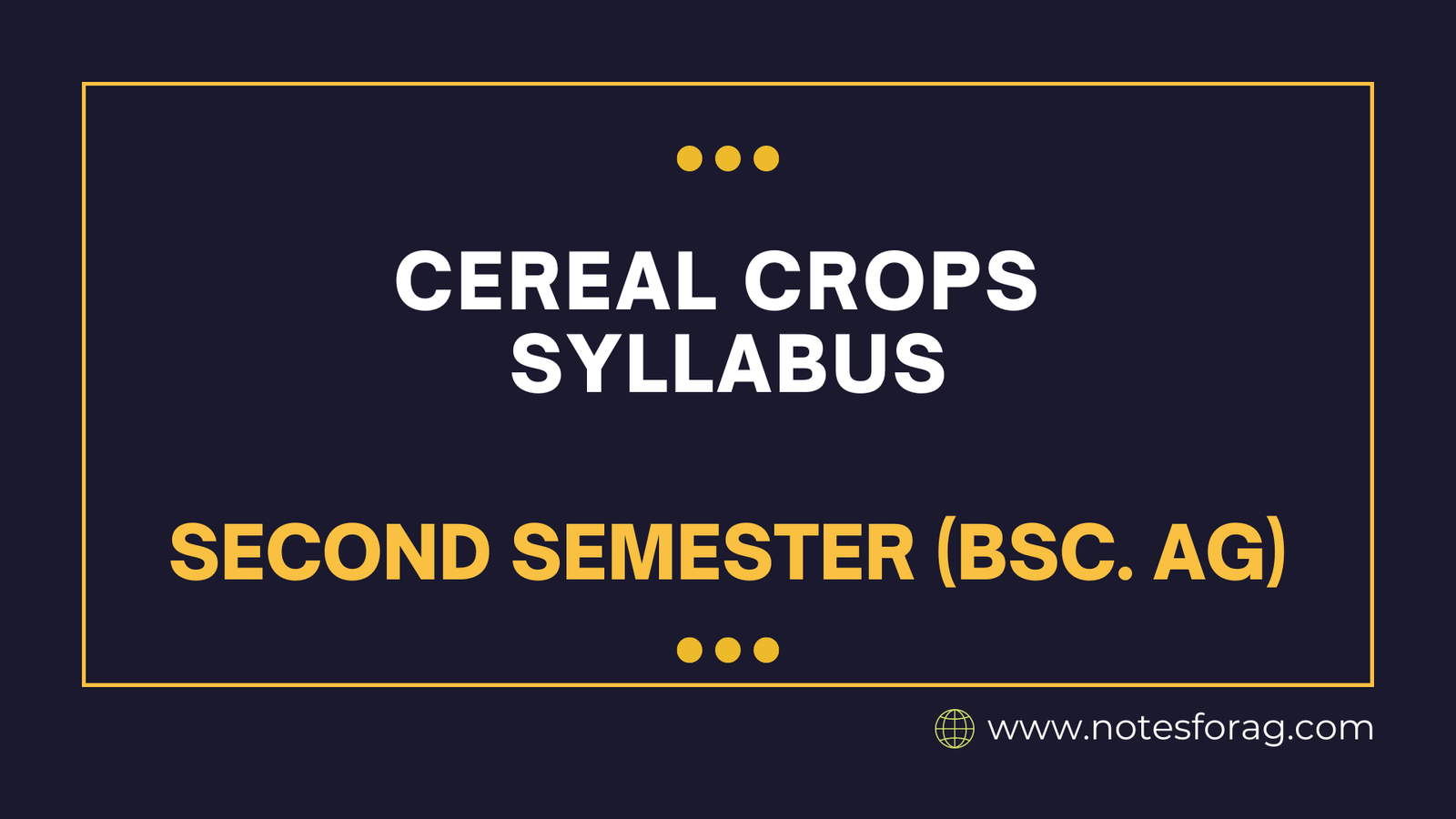| Course Code | AGR 102 |
| Course Title | Cereal Crops |
| Credit Hour | 3(2+1) |
| Full Marks | 75 |
| Theory | 50 |
| Practical | 25 |
Objectives
Upon the completion of this course, the students will know about improved agronomical practices of cereal crop production and the opportunities, constraints, and current research status in cereal crops research.
Syllabus of Cereal Crops in Bsc. Agriculture
Introduction and importance, origin, distribution, area, production and productivity, improved cultural practices, land preparation, recommended varieties, nursery raising methods, seed treatments, seed rate, sowing time, sowing methods, fertilizers, weed and water management, Maturity judging, harvesting, threshing, cleaning, drying and storage, the current status of research, yield and constraints and opportunities in rice, wheat, maize, millet, buckwheat, and barley.
Course Outline
A. Theory
| S.N | Topic / Chapter Name | No. of Lectures. |
| 1 | Rice 1.1 Introduction and importance, origin distribution, area, production, and productivity in Nepal 1.2 Soil and climatic requirement and their effect on production 1.3 Morphology, growth, and development 1.4 Taxonomy – indica, japonica, and javanica, important varieties and hybrids of rice in Nepal 1.5 System of rice culture, land preparation, and puddling 1.6 Raising of nurseries: wet, dry, dapog, and modified dapog nurseries, seed rate, seed treatment, and spacing 1.7 Mineral nutrition and fertilizer management: N, P, K, zinc, iron, and bio-fertilizers, integrated nutrient management, steps for increasing fertilizer use efficiency in rice 1.8 Water use and water management practices: water requirement, critical stages, Weeds, and weed control: crop-weed competition, principles, and methods of weed control 1.9 Maturity judging, harvesting, threshing, cleaning, drying and storage | 10 |
| 2 | Wheat 2.1 Introduction and importance, origin, distribution, area, production and productivity, ecologies in Nepal 2.2 Introduction and importance, origin, distribution, area, production and productivity, ecologies in Nepal 2.3 Soil and climatic requirement, classification, important varieties 2.4 Land preparation, seed treatments, seed rate, sowing time, sowing methods 2.5 Mineral nutrition and fertilizer management, water use, and water management practices 2.6 Weeds and weed controls, maturity judging, harvesting, threshing, cleaning, drying, and storage | 6 |
| 3 | Rice wheat system in NepalCoverage, status, factors affecting yield in the system, management issues | 1 |
| 4 | Maize 4.1 Introduction and importance, origin, distribution, area, production, and productivity in Nepal 4.2 Soil and climatic requirement, classification, important varieties, and hybrids 4.3 Morphology, growth, and development 4.4 Land preparation, seed treatments, seed rate, sowing time, sowing methods 4.5 Mineral nutrition and fertilizer management, water use, and water management practices 4.6 Weeds and weed controls, maturity judging, harvesting, threshing, cleaning, drying, and storage | 6 |
| 5 | Finger millet 5.1 Introduction and importance, origin, distribution, area, production, and productivity 5.2 Land preparation, seed treatments, seed rate, sowing time, sowing methods, fertilizers, weed, and water management, Maturity judging, harvesting, threshing, cleaning, drying, and storage | 2 |
| 6 | Buckwheat 6.1 Introduction and importance, origin, distribution, area, production, and productivity 6.2 Land preparation, seed treatments, seed rate, sowing time, sowing methods, fertilizers, weed, and water management, Maturity judging, harvesting, threshing, cleaning, drying, and storage | 1 |
| 7 | Barley Introduction and importance, origin, distribution, area, production and productivity, land preparation, seed treatments, seed rate, sowing time, sowing methods, fertilizers, weed and water management, Maturity judging, harvesting, threshing, cleaning, drying, and storage | 1 |
| 8 | Introduction to minor cereal sorghum, Perl millet, Foxtail, Proso millet, and triticale | 1 |
| 9 | Current status of cereal research in Nepal | 1 |
| Total | 30 |
B. Practical
| S.N | Topic / Chapter Name | No. of Lectures. |
| 1 | Field preparation for cereal crops | 2 |
| 2 | Raising of rice seedlings | 1 |
| 3 | Sowing of cereal crops | 1 |
| 4 | Study of growth stages of rice, wheat, and maize | 2 |
| 5 | Practices on numerical exercises of fertilizers and pesticides requirements of cereal crops | 2 |
| 6 | Fertilizer application on the cereal crops | 2 |
| 7 | Maturity judging of cereal crops | 1 |
| 8 | Identification and control of major weeds of rice, wheat, and maize | 1 |
| 9 | Yield estimation and harvesting of cereal crops grown during the season | 1 |
| 10 | Study of plant biometrics of cereal crops | 1 |
| 11 | Visit and study various researches conducted at research sites of the National Maize Research Program | 1 |
| Total | 15 |
References
- De Dutta, S.K. 1981. Principles and Practices of Rice Production. John Wiley and Sons, New York.
- Fageria, N. K., V. C. Baligar and C. A. Jones. 1990. Growth and mineral nutrition of field crops. Marcel Dekker, Inc., New York
- M. Pal, D. Jayanta and R. K. Rai. 1996. Fundamentals of Cereal Crop Production. Tata McGraw-Hill Publishing Co. Ltd., New Delhi.
- Martin, J. H., W. H. Leonard, and D. L. Stamp. 1976. Principles of Field Crop Production. Third Edition. Macmillan Publishing Co. Inc., New York
- Nanda, J. S. and P. K. Agrawal. 2008. Botany of field crops – I. Kalyani Publishers, Ludhiana Prasad, R. 2004. Textbook of Field Crops Production. ICAR, New Delhi
- Reddy, S.R. 2009.Agronomy of Field Crops.Kalyani Publishers, Ludhiana.
- Singh, C. 2001. Modern Techniques of Raising Field Crops.Oxford and IBH Pub. Co. Pvt. Ltd. New Delhi.
- Thakur, C. 1979. Scientific Crop Production.Vol. 1 and 2. Metropolitan Book Co. Pvt. Ltd., New Delhi.
- Varma, S.C. and Singh, M.P. 1992.Agronomy of New Plant Types, Tara Publications, Varanasi.

